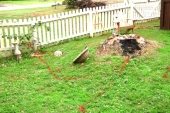


Stephen Lloyd wrote:
solomon martin wrote:Here is a method that may be less labor intensive than a full stone or concrete foundation: build a series of masonry (stone) piers that will support your floor beams at 8 or 10ft. intervals. In between the piers, hang expanded metal lathe and coat with mortar to make a 1/2 inch thick ferrous cement "foundation" walls. You are still using cement, but only a fraction compared to a concrete stem wall. You can increase the insulation factor by applying cob or something to the interior of the ferrous cement.
I'm planning to do something similar (or identical, if I understand your description) to what you wrote here. I will be using concrete piers, with copious rebar to span the piers, laying mesh over that, and troweling concrete into the mesh. I will probably have several layers of mesh to make for a durable floor. I'm interested in keeping lumber usage to a minimum.
Any additional clarification about your post would be useful---


William James wrote:Ryan,
Something tells me you're neighbors are going to hate you. Good job. You might want to bake them some cookies as a peace offering until food starts popping out of your yard.
William

 The biggest thing I think will be the lack of sun due to the shading from the house and trees, but it should still get 6-7 hours of full light in the summer. I also need to finalize the overflow areas within the swales. There is expected to be some rain tonight, if so I'll watch it then.
The biggest thing I think will be the lack of sun due to the shading from the house and trees, but it should still get 6-7 hours of full light in the summer. I also need to finalize the overflow areas within the swales. There is expected to be some rain tonight, if so I'll watch it then.

William James wrote:I would go for the thing that erks you the most. Usually it is a good design practice to work on the difficult areas first, since the easy areas will remain easy down the line.
Getting cultivation raised above the seasonal rain water line should be a high priority, as would digging even a small swale (6-10 inches is fine) on contour to slow down that water coming into your yard. It's amazing what even a small ditch can do to improve the water situation immediately downhill.
Try to find out where the water is coming from. You can find incline and contour with a bunyip, which you can make yourself. Once you get an idea of where the water is coming from, block it with swales. In the swales add biomass, chips would be optimal choice, grass less optimal but it works. On the land between swales go vertical. This could be simple earth mounds you cultivate on top of, neat and pretty raised garden beds, or hugelkulture. In the other areas go with nitrogen fixers like clover, dandelion, and the like to create a walkable area that does something for you. As time goes on work in hardy dwarf fruit trees that can stand wet feet, perennial edibles, and helper perennials like comfrey.
Getting things vertical is probably going to be the most time and money consuming. Raising earth less easy if you're already in a depression, but it can be done.
That's what I would do if your yard was mine.
William

William James wrote:Your yard looks small.
Once you start working on it you'll see how big it really is...
With that in mind, my advice is to start small. Let it grow, piece by piece, with your experience. Your tendency will be to overextend yourself and when that happens, keeping up is difficult, often leading to burnout or a sense that it's just not coming together how you imagined. Work at first on small things in different areas and they will come together in the end. Make your paths to and from your small experiments opportunities for cultivation, as you will be walking along them anyway.
If I had taken that advice, I would be thanking whoever gave it to me now.
William

Aljaz Plankl wrote:Can you get one year old cow manure, something similar or compost...?
